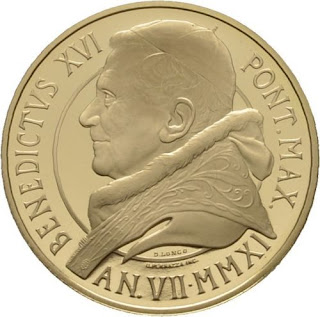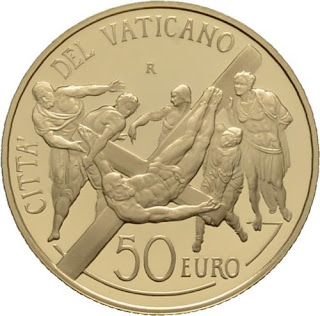Vatican 50 Euro Gold Coin 2011 The Crucifixion of St. Peter, Michelangelo Buonarroti
Subject: The restoration of the Pauline Chapel, it is located in the Apostolic Palace in Rome.
The restoration of the Pauline Chapel was presented on the 30th of June 2009. The Chapel is located in the Vatican Apostolic Palaces and Paul III Farnese commissioned to Antonio da Sangallo (1537-42) to built it; subsequently Michelangelo was entrusted to paint the two frescoes reproducing the Conversion of St. Paul and the Crucifixion of St. Peter (1542-50). Since its creation it has always been a place of prayer and meditation for Popes and the pontifical family.
The restoration began in 2002, under the direction of the art historian Arnold Nesselrath, and has been realized by the staff of the Restoration Painting Laboratory with the coordination of Maurizio De Luca and the financial support of the Patrons of the Arts.
In addition to the restoration of the paintings, the presbitery was reaorganized including a new lighting system, which highlights the paintings.
Obverse: Bust of Pope Benedict XVI.
Reverse: The Crucifixion of St. Peter is a fresco painting by the Italian Renaissance master Michelangelo Buonarroti (c. 1546–1550).
Composition: Gold.
Fineness: 0.917.
Weight: 15 g.
AGW: 0.4422 oz.
Diameter: 28 mm.
The Crucifixion of St. Peter
The Crucifixion of St. Peter is a fresco painting by the Italian Renaissance master Michelangelo Buonarroti (c. 1546–1550). It is housed in the Cappella Paolina, Vatican Palace, in the Vatican City, Rome. It is the last fresco executed by Michelangelo.
The artist portrayed St. Peter in the moment in which he was raised by the Roman soldiers to the cross. Michelangelo concentrated the attention on the depiction of pain and suffering. The faces of the people present are clearly distressed. Pope Paul commissioned this fresco by Michelangelo in 1541 and unveiled it in his Cappella Paolina.
Restoration of the fresco completed in 2009 revealed an image believed to be a self-portrait of Michelangelo himself. The figure is standing in the upper left corner of the fresco, wearing a red tunic and a blue turban. Blue turbans were often worn by Renaissance sculptors to keep the dust out of their hair.
The image is set within the context of a modestly executed mountainous background. Michelangelo did not expend much effort in rendering the background in great detail. Vasari states, “There are no landscapes to be seen in these scenes, nor any trees, buildings or other embellishments and variation.” The mountains are painted in a faint blue hue, which perhaps is intended to increase the depth of field through atmospheric perspective. The land represented in the middle ground and foreground is a pale yellow-green that is in some places more of a yellow ochre in color. The only real vertical elements in the painting are the figures, which occupy most of the foreground. Many clusters of people surround a single large central figure that is mounted on a crucifix. The most impressive formal attribute of this painting (besides its considerable size) is its central compositional element. Unlike the many representations of the martyrdom of Peter that came before it, this particular manifestation depicts the raising of the cross- the moment before the crucifixion has truly begun. The angle of the crucifix activates the composition and makes what might otherwise be a static image into something much more dynamic. The strong diagonal creates a cyclical visual pattern for the eyes to follow. If one reads the painting from left to right, the figures ascending the steps on the bottom left lead the eye upward towards a cluster of equestrian figures. They direct the eye to the group of people located on the top right corner, which in turn lead to one end of the crucifix. The other end of the crucifix points again to the men who are climbing up the steps. Michelangelo also created many strong diagonals with the placement of his figures and the extension of their arms and legs towards a central point of convergence. The positioning of St. Peter himself is often noted as the most interesting innovation Michelangelo implemented in this piece. He defied convention by positioning Peter’s upper body so that it cranes upward and twists his neck around so that his eyes make contact with the viewer. The saint’s penetrating stare gives the impression that he is demanding that the audience bear witness; that they do not avert their eyes, that his sacrifice would not be in vain. This is a far cry from the typical passive, uplifted gaze that is seen on the face of countless martyrs in the depiction of their final moments.

